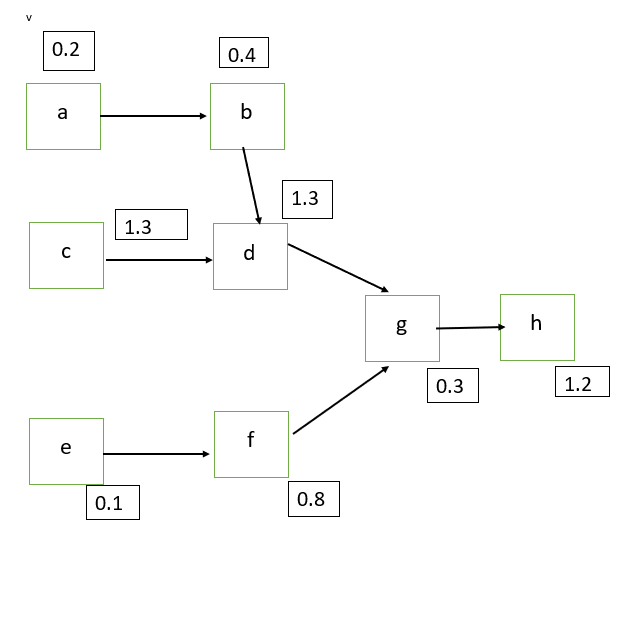(1) Enter the number of the following tasks for each of the tasks shown in the table below. Task Number of Following Task a b c d e f g h (2)Assign tasks to stations in order of the greatest number of following tasks. Use greatest positional weight as a tiebreaker rule. Work Station Task Assigned I II III IV (3) What is the daily output under this arrangement a using the cycle time from Part b(1)? (Round your answer to 2 decimal places.) Percentage of idle time ________ % (4) Determine the output rate that would be associated with using the maximum cycle time. (Round your answer to 2 decimal places.) Rate of output ______________ units per day b. (1) What is the shortest cycle time that will permit use of only two workstations? (Round your answer to 1 decimal place.) Shortest cycle time ___________ minutes (2) Determine the percentage of idle time that would result if two stations were used and each station was loaded with the worktime shown in Part b(1). (Leave no cells blank - be certain to enter "0" wherever required.) Percentage of idle time ____________% (3) What is the daily output under this arrangement a using the cycle time from Part b(1)? (Round your answer to 2 decimal places.) Daily output ______________unit per day (4) Determine the output rate that would be associated with using the maximum cycle time. (Round your answer to 2 decimal places.) Rate of output __________uniits per day
(1) Enter the number of the following tasks for each of the tasks shown in the table below.
| Task | Number of Following Task |
| a | |
| b | |
| c | |
| d | |
| e | |
| f | |
| g | |
| h |
| Work Station | Task Assigned |
| I | |
| II | |
| III | |
| IV |
| Percentage of idle time | ________ % |
(4) Determine the output rate that would be associated with using the maximum cycle time. (Round your answer to 2 decimal places.)
| Rate of output | ______________ units per day |
b.
(1) What is the shortest cycle time that will permit use of only two workstations? (Round your answer to 1 decimal place.)
| Shortest cycle time | ___________ minutes |
(2) Determine the percentage of idle time that would result if two stations were used and each station was loaded with the worktime shown in Part b(1). (Leave no cells blank - be certain to enter "0" wherever required.)
| Percentage of idle time | ____________% |
(3) What is the daily output under this arrangement a using the cycle time from Part b(1)? (Round your answer to 2 decimal places.)
| Daily output | ______________unit per day |
(4) Determine the output rate that would be associated with using the maximum cycle time. (Round your answer to 2 decimal places.)
| Rate of output | __________uniits per day |

The Precedence diagram will be :

Maximum cycle time= Sum of tasks time = 0.2+0.4+0.3+1.3+0.1+0.8+0.3+1.2=4.6 minutes
Minimum cycle time= length of longest task=1.3 minutes
A number of work stations required=(sum of total task times) /(cycle time)
= 4.6/1.3
= 3.53 rounded off to 4
Therefore four workstations are required.
Trending now
This is a popular solution!
Step by step
Solved in 3 steps with 1 images


